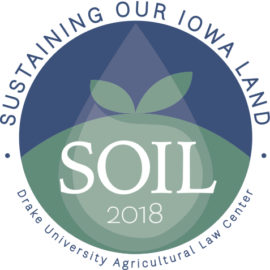Posted on September 25, 2018
Lessons from SOIL 2018
You can’t predict exactly what will happen when you bring together 150 dedicated Iowans and ask a dozen farmers, scientists, conservationists, and community leaders to share their visions for Iowa’s water and land – but you can be sure it will be interesting. That was very true at SOIL 2018.
To begin – speakers and attendees agreed on several key points.
First, Iowa is seriously underfunding any real efforts at protecting water quality and soil. There was strong support for raising the sales tax to provide permanent funding for the natural resource protection efforts Iowa needs.
Second, we have the farming practices needed to help improve soil health and protect water quality – the two most valuable are widespread adoption of cover crops and using wetlands and riparian buffer strips to filter water and build soil.
Third, there is a growing recognition we need to focus on soil health, especially improving water infiltration capacity so the soil can withstand the frequent large rains we are experiencing.
Fourth, changing our attitude to the soil means ridding ourselves of the notion there is a tolerable level of soil loss.
Fifth, we need opportunities for people to get outdoors, to be on our rivers in we want them to understand how land and water are part of our eco-system and to recognize how a healthy environment is one of our most effective tools for economic development.
Here are some specific ideas shared by speakers:
Dr. Jerry Hatfield of the USDA explained our need to promote biologic activity in the soil. Soil degradation is limiting the ability of soil to absorb water, which is why we have terrible surface runoff from large rains.
Liz Garst, a farmer and banker from Coon Rapids, said we need to develop realistic views on soil regeneration and get rid of the idea of tolerable soil loss. She reminded us we are trying to do what no civilization been able to – solve soil erosion. Doing so will require us to overcome what her grandfather called “the despotism of custom.”
Seth Watkins, a cattleman from Southwest Iowa, focused on rural economies and community life; for example, expanding opportunities for tourism from hunting. Seth said, “We have never filled our hotels for corn season.” Grazing the way Seth does allows him to employ a variety of conservation and soil health building practices.
Jennifer Terry, the Iowa farm girl heading the Iowa Environmental Council, said our lakes are sick and we need to restore them to health. She invited us to learn what neighboring states are doing. Her most powerful suggestion was out need for more diversity of voices and involving women leaders in our efforts.
Larry Weber from the University of Iowa reminded us how critical it is to take a watershed approach. He highlighted the growing number of Presidential disaster declarations from flooding in Iowa and the frequency of 10 inch rains. He left us with sobering data how trend lines show Iowa’s nutrient export has increased in recent years.
Matt Russell from Interfaith Power and Light brought a hopeful message for how farmers can lead our nation’s response to climate change. Doing so may unlock significant economic opportunities and pay for the healthy soil and water quality central to addressing climate change.
Jim Pease, a wildlife biologist, explained Iowa does have a vision plan for wildlife. It is based largely on having more permanently protected public land with larger blocks and contiguous corridors of riparian buffers to continue the wildlife restoration work underway.
Hannah Inman of the Greater Outdoor Fund detailed the Central Iowa water trails plan and how business community supports outdoor amenities to aid in job creation, recruitment and retention.
The great news coming from SOIL 2018 is that Iowans have a vision for our resource future and are looking for ways to bring their hopes alive. We will keep exploring their stories.



